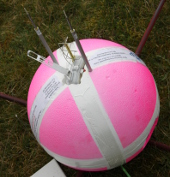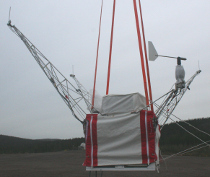Balloon-borne turbulence measurements with LITOS
The balloon-borne instrument LITOS (Leibniz Institute Turbulence Observations in the Stratosphere) measures wind and temperature fluctuations with very high vertical resolution. The wind sensor is a constant temperature anemometer (CTA), which facilitates the convective cooling effect on a thin (5 µm) wire, please see sketch. The wire is held on a constant temperature of ca. 230°C by the control electronics. From the heating voltage, the wind velocity can be obtained using a calibration. Since the balloon moves with the mean wind in its altitude, and the payload hangs 100 m below, the CTA sensor measures the vertical change of the horizontal wind.
The temperature is measured using a constant current anemometer, which is in principle a resistance thermometer in form of a thin (2 µm) wire. Its very low heat capicity results in a quick response.
Both sensors are sampled with a rate of 8 kHz, which gives the sub-millimetre resolution assuming an descent rate of 5 m/s. Since 2016 measurements are performed on downleg to avoid signal contaminations by the wake of the balloon or other objects. To determine the atmospheric background parameters (pressure, temperature, humidity, wind via GPS), a standard radiosonde is used.
LITOS can be launched with a 4 kg payload from every radiosonde station (see photograph on the left). Several successful flights were performed from the grounds of our institute at Kühlungsborn. Furthermore, LITOS was flown in an extended version with several sensors on a large (160 kg) payload within BEXUS campaigns (photograph on the right side).


The power spectral density (PSD) of wind fluctuations is plotted for the height range from 10.27 to 10.28 km. An inertial regime with a −5/3 slope and the transition to the viscous subrange with a −7 slope is identified. The part below ~10−2 m spatial scale with approximately constant PSD corresponds to the instrumental noise level. Using a fit of the Heisenberg turbulence model, the inner scale l0 is obtained, which marks the transition from the inertial to the viscous subrange. Out of it, the energy dissipation rate is obtained by ε = c ν3/l04 (c: constant, ν: kinematic viscosity).
Selected publications
- J. Söder, C. Zülicke, M. Gerding und F.-J. Lübken, High-resolution observations of turbulence distributions across tropopause folds, J. Geophys. Res., 126(6), e2020JD033857, doi:10.1029/2020JD033857, 2021.
- J. Söder, M. Gerding, A. Schneider, A. Dörnbrack, H. Wilms, J. Wagner and F.-J. Lübken, Evaluation of wake influence on high-resolution balloon-sonde measurements, Atmos. Meas. Tech., 12, 4191-4210, doi:10.5194/amt-12-4191-2019, 2019.
External Links
- Chair of fluid dynamics at the University of Rostock
- Constant temperature anemometers from Dantec Dynamics A/S














